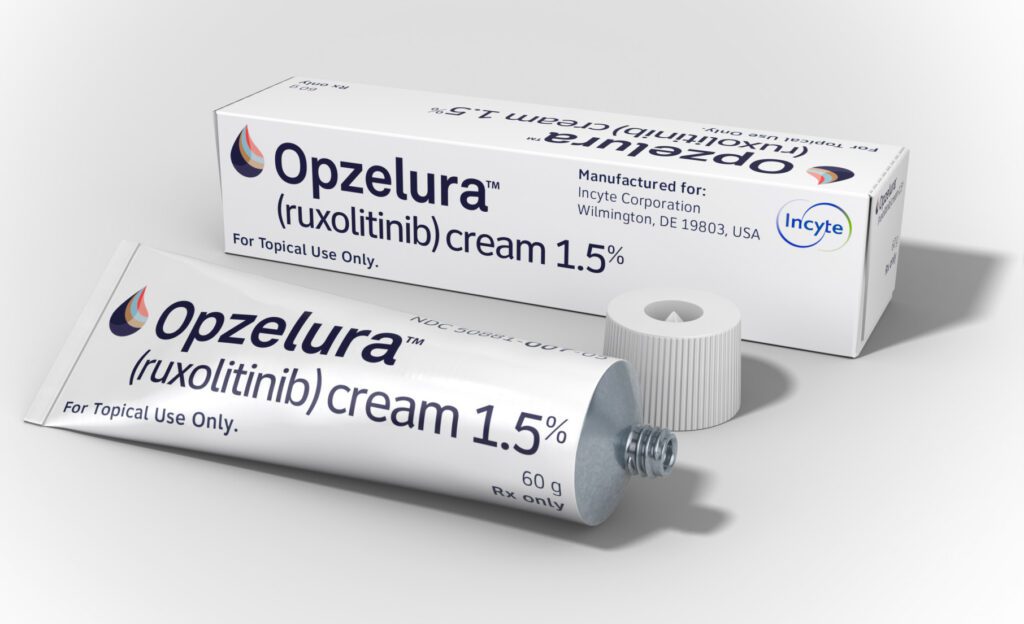Vitiligo, a chronic autoimmune disorder that causes patches of skin to lose pigment or color, has confounded the medical field for the vast majority of its existence—and as a patient, I can vouch.
 When I was diagnosed with vitiligo almost two decades ago, it became clear that the options for treatment were slim and were neither effective nor long-lasting. Most treatments were limited to topical steroids that thinned the skin (among other side effects) and rarely worked. In fact, when I was diagnosed, there was still debate over whether or not vitiligo was in fact an autoimmune disease, and its ineffective treatments reflected that debate.
When I was diagnosed with vitiligo almost two decades ago, it became clear that the options for treatment were slim and were neither effective nor long-lasting. Most treatments were limited to topical steroids that thinned the skin (among other side effects) and rarely worked. In fact, when I was diagnosed, there was still debate over whether or not vitiligo was in fact an autoimmune disease, and its ineffective treatments reflected that debate.
As a result, I saw the patches slowly enlarge as my self-esteem shrank. When I wasn’t covering up more and more, I was sitting alone in the sun desperately trying to prevent the patches from growing, a tactic that resulted in severe sun burns and only limited to temporary patchy repigmentation. Eventually, I gave up trying to treat the disorder and resorted to coverups and makeup. It was a lonely experience, but I was far from alone and, in fact, am reflective of the typical patient experience.

“Vitiligo patients suffer from moderate to severe symptoms of depression in about 50% of cases,” explained Jonathan Dickinson, Europe General Manager and Executive Vice President at Incyte, the company that has developed the first viable vitiligo treatment option. “And you can see that around 25% of patients are actually diagnosed with clinical depression. It is well documented that there’s been a huge stigmatization for patients associated with the disease.”
Indeed, until recently, vitiligo hid in the corners of society. Michael Jackson, for example, famously bleached his skin, and it was little known why at the time. It turns out, the singer had developed a fast-spreading version of vitiligo and chose one of the most extreme forms of treatment available at the time: complete depigmentation. Yet today, models like Winnie Harlow, are literally changing the face of fashion by making vitiligo a publicly known condition—and are praised for their uniqueness and beauty.
And like the visibility of the disorder, the science behind treating it is seeing its own profound changes and innovation in the form of ruxolitinib. I sat down with Incyte’s Jonathan Dickinson and Jim Lee, Group Vice President, Head Inflammation and AutoImmunity, to talk about the advances in treatment for vitiligo, as well as how their new drug, Opzelura, is poising itself to go global and change the vitiligo treatment as we know it.
The first viable option for vitiligo
Ruxolitinib is a class of medicine that is called a Janus kinase (JAK) inhibitor, which targets the immune system, and is the active drug in Incyte’s new medication Opzelura. Discovered about a decade ago, Incyte was looking to develop a JAK inhibitor for a number of conditions. When the science behind what causes vitiligo caught up with the development of the drug, Incyte realized that it may have the first viable treatment option for vitiligo, so it got to work.

“This is one of those really nice examples of when you follow the science and find that it takes you along this certain path, in this case vitiligo, then you are really able to make a difference for patients,” said Dickinson.
Innovation around the treatment of vitiligo has been an uphill battle for a long time, making the development of Opzelura even more exciting for patients. “When vitiligo was first described and followed,” explains Lee, “people really didn’t understand what drove the disease. And 20-25 years ago, we didn’t really understand what caused it. However, we eventually learned it’s an autoimmune condition, then we learned which immune cells were involved, and then what cytokines were involved. That’s typically what happens with most conditions, especially in the immune space. Clinicians and scientists work to discover what’s happening and then develop treatments for those patients.”

Vitiligo’s existence in the autoimmune space speaks to another historic issue around the treatment of these disorders: the fact that understanding around autoimmune disorders still has a lot of ground to cover. “Studying autoimmune diseases like vitiligo is very humbling,” explains Lee. “Within the same disease, for example, you see some patients have different drivers of disease. And even at the cellular level on the skin, some patients have a different process that leads to the same disease. That is what made understanding of the disease and treating it very challenging early on.”
Even the types of vitiligo differ among patients. For example, Opzelura treats a type of vitiligo called nonsegmental vitiligo, meaning that its patterning is mirrored on each side of the body (by comparison, segmental vitiligo only occurs on one side of the body, or another and has a very different disease expression). Additionally, triggers for vitiligo are also variable as some patients have vitiligo occur early in life, while it does not occur in others until later in adolescence. For some patients, vitiligo is tied to stress responses, and for others, it is more closely tied to genetics. The differences go on and on. Even treatment response vary among patients, with repigmentation happening quickly in some and more slowly in others.
“There are thousands, if not millions, of patients with this disorder, and with them comes thousands of different variations and that make it very challenging to understand completely what’s happening for the patients,” says Lee. “I think what we’re learning is that, because some patients have different responses, we have to now turn to personalized medicine to really try to help the different patients and how they present.”
Yet, the development of Opzelura has already changed the landscape of vitiligo treatment since its approval in September of 2021. The tight-knit vitiligo community took notice.
“Many doctors, and honestly patients, just gave up,” explains Lee. “The patients were coming in, and the doctor said, ‘Listen, we’ve tried steroids, we’ve tried calcineurin inhibitors, and yeah, they’re okay, but they aren’t that effective.’ And so patients kind of went away. But what we’re seeing now is an excitement within the patient community around Opzelura that is helping drive a better awareness among treating physicians.”
My own dermatologist was excited about the treatment during an appointment in the fall of 2022. In response to my lamentation that I understood that there was no real treatment option for vitiligo, she said, “No, this one is different.”
To Europe and beyond
So far, Opzelura has been welcomed and well received state-side, and before long, it will be available in Europe as well. Opzelura has been greenlit by the various necessary European institutions, and Incyte expects it to be available around the beginning of May. While there will still be some hoops to jump through regarding coverage for patients, Incyte is working with physicians to give patients access to the drug as early as possible. Patient excitement in Europe has already been heard loud and clear.
 But it is important to remember that drugs like Opzelura signify a leap in the treatment of vitiligo, not a finish line. “We’re not done here with Opzelura,” says Lee. “We have another program with an oral JAK inhibitor, and we shared that data at the American Academy of Dermatology a couple of weeks ago. We have recently purchased a company called Villaris, which has developed an anti-IL-15 receptor beta. And we also have two additional molecules in development for vitiligo patients, specifically for patients with a little bit more extensive disease.”
But it is important to remember that drugs like Opzelura signify a leap in the treatment of vitiligo, not a finish line. “We’re not done here with Opzelura,” says Lee. “We have another program with an oral JAK inhibitor, and we shared that data at the American Academy of Dermatology a couple of weeks ago. We have recently purchased a company called Villaris, which has developed an anti-IL-15 receptor beta. And we also have two additional molecules in development for vitiligo patients, specifically for patients with a little bit more extensive disease.”
With the increased diversity in vitiligo treatment comes a better ability for physicians to practice personalized medicine, as well as increased treatment method options.
“As an autoimmune condition, you’re going to have to have chronic dosing, and some patients may not want to apply cream for 5-10 years,” explains Lee. “Patients may want to go on either a pill or an injectable, for example. So we’re excited. The science is really driving us. We know that patients need better treatments, and we’re still working to bring additional treatments for vitiligo patients in the future.”




